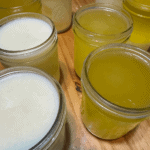How to Dry Render Tallow
We provide a simple guide on how to dry render tallow, focusing on the essential steps to ensure a clean, pure, and shelf-stable fat. Whether you're using it for cooking, skincare, or soap-making, you'll learn the best techniques for efficiently removing moisture and impurities from tallow, resulting in a high-quality end product.
Equipment
- crockpot
- cheesecloth
- fine mesh strainer
- sharp knife
- cutting board
- food processor or meat grinder optional
- Large Bowl
Materials
- beef or deer suet fat from behind the kidneys, frozen
Instructions
- Using a sharp knife, cut the suet into chunks. Discard any discolored pieces. Chunks can be 1-2 inch pieces if you're using a food processor. If using a meat grinder, allow the suet to thaw because it will go through the grinder easier. If you are not using a food process or meat grinder, cut the chunks into the smallest pieces that you can.
- Put chunks of suet into the food processor and pulse until it looks crumbly. Pour the crumbles into a large crockpot, pot, or roaster.
- Put the cooker on low heat and the suet will start to melt. Leave the lid off, you don't want to trap moisture in there. Scrape down the sides to make sure it doesn't burn to the sides.
- Once a lot of the suet has melted you'll start to see bubbles coming up, this is the moisture from the fat bubbling out of the suet. All the water needs to come out in order for your tallow to be shelf-stable. Try not to let the temperature get above about 175ºF so the nutrients don't break down in the tallow. Heating on high heat will damage the quality of your tallow.
- If you're using the tallow for skincare, I like to strain out the solid pieces after a couple of hours. This will make it so you only have the purest tallow in your crockpot and it isn't cooking in the other pieces of fat. It will help to reduce the smell so your skincare doesn't have a beefy or tallow smell. Set the solids aside to finish rendering later for cooking or soap.
- Once all the bubbling has stopped (several hours later), strain the tallow using a fine mesh strainer and cheesecloth into a bowl. Discard any pieces that were strained out.
- If you strained out solid pieces earlier in the process, add them back into the crockpot and let that render down until it stops bubbling. Strain it and discard the solid pieces. This may have a little more smell but is great to use for soap or cooking.
- Once the tallow has cooled completely, cut it to remove it from the bowl. Scrape any discolored spots off of the bottom of the tallow cake and discard. You can remelt and strain again to make sure all the impurities are out if you want. Now your tallow is ready to use! Store it at room temperature in a zip lock bag, mason jar, or other container. Make sure the tallow has cooled completely before you close up the container.
